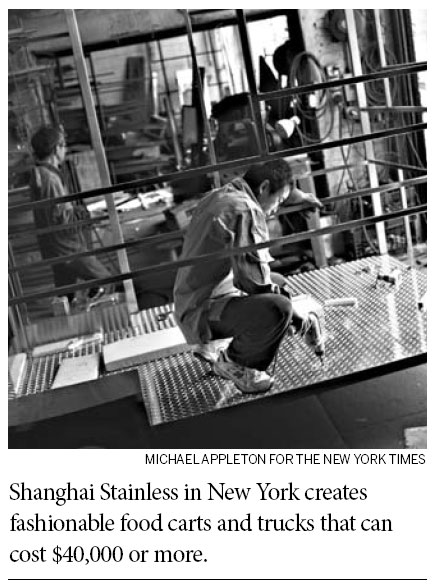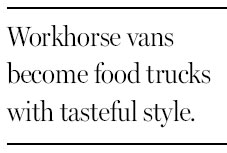Culinary artistry on urban wheels
Updated: 2011-11-13 07:00
By Glenn Collins(The New York Times)
|
|||||||||

Some of New York's fanciest food trucks come from a nondescript one-story factory crowned with razor wire, teeming with 15 workers arrayed on an assembly line.
Shanghai Stainless Product & Design Company has fabricated trucks for some of the city's best-known names of roaming specialty food, including All American Diner, Korilla BBQ, Red Hook Lobster Pound, Treats Truck, Van Leeuwen Ice Cream and Wafels & Dinges, as well as four members of the Rickshaw Dumpling fleet - in all, some 30 mobile food factories since 2008.
In addition, the company turns out about 60 food carts each year.
The New York City Department of Health lists seven other truck-and-cart manufacturers in Brooklyn, Queens and the Bronx, and there are dozens more in fierce competition. But Shanghai Stainless in Brooklyn is a standout in this seemingly ho-hum industrial metier. The company, led by general manager Ernie Wong, brings surprising artistry to the design of the stolid, lumbering food truck, and its success has been integral to the evolution of New York's nouveau mobile-dining phenomenon.
"Ernie's business has grown along with the food trucks, and he's had growing pains just trying to keep up," said David Weber, president of the New York City Food Truck Association, a trade group. "And he is extremely creative about getting the maximum from a limited space."
Robert Arbor, the owner of Le Gamin, said, "Ernie is a specialist - the king of stainless steel on wheels."
Trucks are greatly confined and their configuration is fanatically considered. "People tell me, 'I need a design,' and I tell them, 'Well, I need your menu,'" Mr. Wong said. "Without that, we can't determine the workflow, which must be tightly planned."
Mr. Wong starts off with detailed computer-assisted design drawings executed by an office expert. "Our design," Mr. Wong said, "creates circles around each person in the unit - so each worker can be within range of their resources. For example, if you're frying, you must be within reach of the freezer."
The entire process takes two to three months. Virtually all food trucks are step vans: boxy, ubiquitous workhorses that are about 75 centimeters from the asphalt and are easy to step into. They afford street-level side windows at customer height.

Mr. Weber explained: "Customers get invested in the story of the truck, so it's important for them to see a hands-on entrepreneur in the window. Restaurants have customers, but food trucks have followers." He estimates that there are some 250 trucks serving savories and sweets on New York's streets compared with a handful a decade ago.
A bargain-basement food-truck makeover can cost as little as $30,000 these days, but Mr. Wong's average is $40,000 to $50,000 and more, and $100,000 is not uncommon for owners demanding fancy features. Aside from the mileage expense of gasoline or diesel fuel, some power-hungry trucks require 25 kilowatts, the power usage of an entire private home.
Mr. Wong uses only restaurant-grade 304 stainless steel in installing propane cooking facilities and generator-powered electric refrigeration units, adding some 2,200 kilograms to the weight of a 4,000-kilogram truck chassis and cargo box.
To Mr. Weber, "food trucks are an incubator for new businesses, for entrepreneurs who can't afford $500,000 to open a restaurant in New York City - but who can afford $100,000 to launch a truck."
The New York Times
(China Daily 11/13/2011 page12)